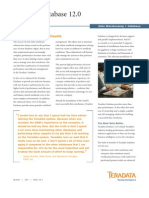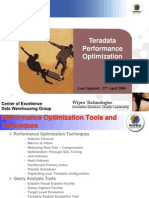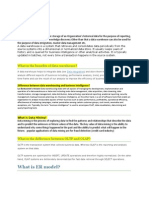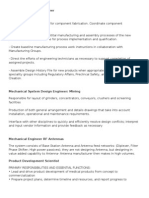0 ratings0% found this document useful (0 votes)
64 viewsPerformance Optimization Technique
The document discusses how Teradata handles mixed workloads and concurrent queries from different users with varying service level requirements. It explains that Teradata automatically balances work across nodes, distributes data and queries evenly for parallelism, avoids bottlenecks through parallel query coordination and dictionary access, queues work to execute concurrently using all available CPUs, and uses priority scheduling to provide different service levels to different users or workloads. Maintaining high concurrency without performance degradation even as the workload scales up is one of Teradata's core competencies for active data warehousing and integrated e-commerce environments.
Uploaded by
shilpakhaireCopyright
© © All Rights Reserved
Available Formats
Download as DOCX, PDF, TXT or read online on Scribd
0 ratings0% found this document useful (0 votes)
64 viewsPerformance Optimization Technique
The document discusses how Teradata handles mixed workloads and concurrent queries from different users with varying service level requirements. It explains that Teradata automatically balances work across nodes, distributes data and queries evenly for parallelism, avoids bottlenecks through parallel query coordination and dictionary access, queues work to execute concurrently using all available CPUs, and uses priority scheduling to provide different service levels to different users or workloads. Maintaining high concurrency without performance degradation even as the workload scales up is one of Teradata's core competencies for active data warehousing and integrated e-commerce environments.
Uploaded by
shilpakhaireCopyright
© © All Rights Reserved
Available Formats
Download as DOCX, PDF, TXT or read online on Scribd
You are on page 1/ 8
*Teradata makes itself the decision to use the index or not - if you are not
careful youspend time in table updates to keep up an index which is no
used at all (one cannot givethe query optimizer hints to use some index -
though collecting of statistics may affectthe optimizer strategy*In the MP-
RAS environment, look at the script "/etc/gsc/bin/perflook.sh". This
will provide a system-wide snapshot in a series of files. The GSC uses this
data for incidentanalysis.* When using an index one must keep sure that
the index condition is met in the subqueries "using IN, nested queries, or
derived tables"* Indication of the proper index use is found by explain log
entry "a ROW HASHMATCH SCAN across ALL-AMPS"* If the index is not
used the result of the analysis is the 'FULL TABLE SCAN' where
the performance time grows when the size of the history table grows*
Keeping up an index information is a time/space consuming issue.
Sometimes Teradatais much better when you "manually" imitatate the
index just building it from scratch.* keeping up join index might help, but
you cannot multiload to a table which is a part of the join index -
loading with 'tpump' or pure 'SQL' is OK but does not perform as
well.Dropping and re-creating a join index with a big table takes time and
space.* when your Teradata "explain" gives '25' steps from your
query (even without theupdate of the results) and the actual query is a join
of six or more tables
Case e.g.
We had already given up updating the secondary indexes - because we
have not hadmuch use for them.After some trials and errors we ended
up to the strategy, where the actual "purchasefrequency analysis" is never
made "directly" against the history table.Instead:1) There is a "one-shot"
run to build the initial "customer's previous purchase" from the"purchase
history" - it takes time, but that time is saved later 2) The purchase
frequency is calculated by joining the "latest purchase" with the"customer's
previous purchase".3) When the "latest purchase" rows are inserted to the
"purchase history" the "customer's previous purchase" table is dropped
and recreated by merging the "customer's previous purchase" with the
"latest purchase"4) By following these steps the performance is not too fast
yet (about 25 minutes in our two node system) for a bunch of almost
1.000.000 latest receipts - but it is tolerable now
(We also tested by adding both the previous and latest purchase to the
same table, but because its size was in average case much bigger than the
pure "latest purchase", the self- join was slower in that case)
*********
MANAGING CONCURRENT WORKLOADS
Integrated e-commerce efforts present many warehouse challenges. Here'show
Teradata can help.
The word e-commerce means many things to many people. Although for
some itconnotes only the Web, the real value of e-commerce can only be
realized when allchannels of a business are integrated and have full access
to all customer information andtransactions. In fact, to me, e-commerce
means using the rich technology available todayto bring added value to the
customer and additional value to the business through allcustomer
interaction channels.Under this definition of e-commerce, an
active warehouse is at the epicenter, providingthe storage and access for
decision making in the e-commerce world. As more and morecompanies
adopt active warehousing for this purpose, data warehouse workloads
areexpanding and changing.If your warehouse relies on a Teradata DBMS,
you'll find that handling the challenge of high-volume, widely varying,
disparate service-level workloads is one of its corecompetencies. One of
the biggest concerns I hear from customers is how to deal with thequickly
rising number of concurrent queries and concurrent users that can result
fromactive warehousing and e-commerce initiatives. Expected service
levels vary widelyamong different groups of users, as do query types. And,
of course, the entire workloadmust scale upward linearly as the demand
increases, ideally with a minimum of effortrequired from users and systems
staff. Here's a look at some of the most frequentquestions I receive on the
subject of mixed workloads and concurrency requirements.
How do I balance the work coming in across all nodes of my Teradataconfiguration?
You don't. Teradata automatically balances sessions across all nodes to
evenly distributework across the entire parallel configuration. Users
connect to the system as a wholerather than a specific node, and the
system uses a balancing algorithm to assign their sessions to a node.
Balancing requires no effort from users or system administrators.
Does Teradata balance the work queries cause?
The even distribution of data is the key to parallelism and scalability in
Teradata. Eachquery request is sent to all units of parallelism, each of which
has an even portion of thedata to process, resulting in even work
distribution across the entire system
For short queries and update flow typical of Web interactions, the
optimizer recognizesthat only a single unit of parallelism is needed. A query
coordinator routes the work tothe unit of parallelism needed to process the
request. The hashing algorithm does notcluster related data, but spreads it
out across the entire system. For example, this month'sdata and
even today's data is evenly distributed across all units of parallelism,
whichmeans the work to update or look at that data is evenly distributed.
Will many concurrent requests cause bottlenecks in query coordination?
Query coordination is carried out by a fully parallel parsing engine (PE)
component.Usually, one or more PEs are present on each node. Each PE
handles the requests for aset of sessions, and sessions are spread evenly
across all configured PEs. Each PE ismultithreaded, so it can handle
many requests concurrently. And each PE is independentof the others with
no required cross-coordination. The number of users logged
on andrequests in flight are limited only by the number of PEs in the
configuration.
How do you avoid bottlenecks when the query coordinator must
retrieveinformation from the data dictionary?
In Teradata, the DBMS itself manages the data dictionary. Each dictionary
table is simplya relational table, parallelized across all nodes. The same
query engine that manages user workloads also manages the dictionary
access, using all nodes for processing dictionaryinformation to spread the
load and avoid bottlenecks. The PE even caches recently useddictionary
information in memory. Because each PE has its own cache, there is
nocoordination overhead. The cache for each PE learns the dictionary
information mostlikely to be needed by the sessions assigned to it.
With a large volume of work, how can all requests execute at once?
As in any computer system, the total number of items that can execute at
the same time isalways limited to the number of CPUs available.
Teradata uses the scheduling servicesUnix and NT provide to handle all the
threads of execution running concurrently. Somerequests might also exist
on other queues inside the system, waiting for I/O from the disk or a
message from the BYNET, for example. Each work item runs in a thread;
eachthread gets a turn at the CPU until it needs to wait for some
external event or until itcompletes the current work. Teradata configures
several units of parallelism in each SMPnode. Each unit of parallelism
contains many threads of execution that aren't restricted toa particular
CPU; therefore, every thread gets to compete equally for the CPUs in
theSMP node.There is a limit, of course, to the number of pieces of work
that can actually have a threadallocated in a unit of parallelism. Once that
limit is reached, Teradata queues work for thethreads. Each thread is
context free, which means that it is not assigned to any session,transaction,
or request. Therefore, each thread is free to work on whatever is next on
thequeue. The unit of work on the queue is a processing step for a request.
Combining thequeuing of steps with context-free threads allows
Teradata to share the processing service
equally across all the concurrent requests in the system. From the users'
point of view, allthe requests in the system are running, receiving service,
and sharing system resources.
How does Teradata avoid resource contention and the resultingperformance and
management problems?
Teradata algorithms are very resource efficient. Other DBMSs optimize for
single-query performance by giving all resources to the single query. But
Teradata optimizes for throughput of many concurrent queries by
allocating resources sparingly and using themefficiently. This kind of
optimization helps avoid wide performance variations that canoccur
depending on the number of concurrent queries.When faced with a
workload that requires more system resources than are available,Teradata
tunes itself to that workload. Thrashing, a common performance failure
mode incomputer systems, occurs when the system has fewer resources
than the current workloadrequires and begins using more processing time
to manage resources than to do the work.With most databases, a DBA
would tune the system to avoid thrashing. However,Teradata adjusts
automatically to workload changes by adjusting the amount of runningwork
and internally pushing back incoming work. Each unit of parallelism
manages thisflow control mechanism independently.
If all concurrent work shares resources evenly, how are different servicelevels
provided to different users?
The Priority Scheduler Facility (PSF) in Teradata manages service levels
among different parts of the workload. PSF allows granular control of
system resources. The systemadministrator can define up to five resource
partitions; each partition contains four available priorities. Together, they
provide 20 allocation groups (AGs) to which portionsof the workload are
assigned by an attribute of the logon ID for the user or application.The
administrator assigns each AG a portion of the total system resources and
ascheduling policy.For example, the administrator can assign short queries
from the Web site a guaranteed20 percent of system resources and a high
priority. In contrast, the administrator mightassign medium priority and 10
percent of system resources to more complex queries withlower response-
time requirements. Similarly, the administrator might assign data
miningqueries a low priority and five percent of the total resources,
effectively running them inthe background. You can define policies so that
the resources adjust to the work in thesystem. For example, you could
allow data mining queries to take up all the resources inthe system if
nothing else is running.Unlike other scheduling utilities, PSF is fully
integrated into the DBMS, not managed atthe task or thread level, which
makes it easier to use for parallel database workloads.Because PSF is an
attribute of the session, it follows the work wherever it goes in thesystem.
Whether that piece of work is executed by a single thread in a single unit
of parallelism or in 2,000 threads in 500 units of parallelism, PSF manages
it without systemadministrator involvement
CPU scheduling is a primary component of PSF, using all the normal
techniques (such asquantum size, CPU queues by priority, and so on).
However, PSF is endemic throughoutthe Teradata DBMS. There are many
queues inside a DBMS handling a large volumemixed workload. All of those
queues are prioritized based on the priority of the work.Thus, a high
priority query entered after several lower priority requests that are
awaitingtheir turn to run will go to the head of the queue and will be
executed first. I/O ismanaged by priority. Data warehouse workloads are
heavy I/O users, so a large query performing a lot of I/O could hold up a
short, high-priority request. PSF puts the high- priority request I/Os to the
head of the queue, helping to deliver response time goals.
Data warehouse databases often set the system environment to allow for fast scans.
Does Teradata performance suffer when the short work ismixed in?
Because Teradata was designed to handle a high volume of concurrent
queries, it doesn'tcount on sequential scans to produce high performance
for queries. Although other DBMS products see a large fall in
request performance when they go from a single largequery to multiple
queries or when a mixed workload is applied, Teradata sees no
such performance change. Teradata never plans on sequential access in the
first place. In fact,Teradata doesn't even store the data for sequential
accesses. Therefore, random accessesfrom many concurrent requests are
just business as usual.Sync scan algorithms provide additional optimization.
When multiple concurrent requestsare scanning or joining the same table,
their I/O is piggybacked so that only a single I/Ois performed to the disk.
Multiple concurrent queries can run without increasing the physical I/O
load, leaving the I/O bandwidth available for other parts of the workload.
What if work demand exceeds Teradata's capabilities?
There are limits to how much work the engine can handle. A successful
data warehousewill almost certainly create a demand for service that is
greater than the total processing power available on the system. Teradata
always puts into execution any work presentedto the DBMS.If the total
demand is greater than the total resources, then controls must be in
place before the work enters the DBMS. When your warehouse reaches
this stage, you can useDatabase Query Manager (DBQM) to manage the
flow of user requests into thewarehouse. DBQM, inserted between
the users' ODBC applications and the DBMS,evaluates each request
and then applies a set of rules created by the system administrator.If the
request violates any of the rules, DBQM notifies the user that the request is
deniedor deferred to a later time for execution.Rules can include, for
example, system use levels, query cost parameters, time of day,objects
accessed, and authorized users. You can read more about DBQM in a
recentTeradata Review article ("Field Report: DBQM," Summer 1999,
available online atwww.teradatareview.com/summer99/truet.html).
How do administrators and DBAs stay on top of complex mixedworkloads?
The Teradata Manager utility provides a single operational system view
for administrators and DBAs. The tool provides real-time performance,
logged past performance, users and queries currently executing,
management of the schema, andmore.
STAYING ACTIVE
The active warehouse is a busy place. It must handle all decision making for
theorganization, including strategic, long-range data mining queries,
tactical decisions for daily operations, and event-based decisions necessary
for effective Web sites. Nevertheless, managing this diversity of work does
not require a staff of hundredsrunning a complex architecture with multiple
data marts, operational data stores, and amultitude of feeds. It simply
requires a database management system that can managemultiple
workloads at varying service levels, scale with the business, and provide
2437availability year round with a minimum of operational staff.
Use COMPRESS in whichever attribute possible. This helps in reducingIO and hence
Improves performance. Especially for attribute having lots of NULL values/Unique
known values.
COLLECT STATISTICS on daily basis (after every load) inorder toimprove performance.
Drop and recreate secondary indices before and after every load. Thishelps in
improving load performance (if critical)
Regularly Check for EVEN data distribution across all AMPs usingTeradata Manager or
thru queryman
Check for the combination on CPU, AMPs, PE, nodes for
performanceoptimization.Each AMP can handle 80 tasks and each PE can handle 120
sessions.
MLOAD Customize the number sessions for each MLOAD jobsdepending on
the1.Number of concurrent MLOAD jobs &2. Number of PE s i n
t he syst eme.gSCENARIO 1
# of AMPS = 10
# of MAx load Jobs handled by Teradata=5 (Parameter whichcan be set
values-5 to 15)# of Sessions per load job= 1 (parameter that can be set
atGlobal or at each MLOAD script level)# of PE's=1So 10*5*1= 50 + 10 (2
per job overhead) = 60 is the Maxsessions on Teradata boxThis is LESS then
120, which is max # of sessions a PE canhandle
SCENARIO 2
#AMPS = 16#Max load Jobs handles by Teradata=15#Sessions per load job=
1#of PE's=1So 16*15*1= 240 + 30 (2 per job ovehead) = 270 (Maxsessions
on Teradata box).This is MORE then 120, which is the max sessions a PE
canhandle.Hence MLOAD fail, inspite of the usage of the SLEEP &TENACITY
features.
Use the SLEEP and TENACITY features of MLOAD for schedulingMLOAD jobs.
Check the TABLEWAIT parameter. If omitted can cause immediateload job failure if
you submit two MLOADS loads that are trying toupdate the same table.
JOIN INDEX - Check the limit on number of fields for a join Index (max16 fields). It may
vary by versionJoin Index is like building the table physically. Hence it has the advantage
likeBETTER Performance since data is physically stored and not calculated ON THEFLY
etc. Cons are of LOADING time(MLOAD needs Join Indices to be droppedbefore
loading) and additional space since it is a physical table
You might also like
- AAN - 2022 - Abstracts Book - Final WebNo ratings yetAAN - 2022 - Abstracts Book - Final Web123 pages
- THE STEP BY STEP GUIDE FOR SUCCESSFUL IMPLEMENTATION OF DATA LAKE-LAKEHOUSE-DATA WAREHOUSE: "THE STEP BY STEP GUIDE FOR SUCCESSFUL IMPLEMENTATION OF DATA LAKE-LAKEHOUSE-DATA WAREHOUSE"From EverandTHE STEP BY STEP GUIDE FOR SUCCESSFUL IMPLEMENTATION OF DATA LAKE-LAKEHOUSE-DATA WAREHOUSE: "THE STEP BY STEP GUIDE FOR SUCCESSFUL IMPLEMENTATION OF DATA LAKE-LAKEHOUSE-DATA WAREHOUSE"2/5 (2)
- RSI Indicator Trading Strategy, 5 Systems + Back Test Results!100% (9)RSI Indicator Trading Strategy, 5 Systems + Back Test Results!22 pages
- SAS Programming Guidelines Interview Questions You'll Most Likely Be AskedFrom EverandSAS Programming Guidelines Interview Questions You'll Most Likely Be AskedNo ratings yet
- Real-Time Analytics: Techniques to Analyze and Visualize Streaming DataFrom EverandReal-Time Analytics: Techniques to Analyze and Visualize Streaming DataNo ratings yet
- What Is Partitioned Primary Index (PPI) in Teradata?: AdvantagesNo ratings yetWhat Is Partitioned Primary Index (PPI) in Teradata?: Advantages5 pages
- Optimizing Oracle E-Business Suite On ExadataNo ratings yetOptimizing Oracle E-Business Suite On Exadata66 pages
- Teradata Architecture For IT and DevelopersNo ratings yetTeradata Architecture For IT and Developers9 pages
- Training Material - Teradata Basics CertificationNo ratings yetTraining Material - Teradata Basics Certification25 pages
- Teradata Database 12.0: Because Performance CountsNo ratings yetTeradata Database 12.0: Because Performance Counts3 pages
- Data Structures Explained: A Practical Guide with ExamplesFrom EverandData Structures Explained: A Practical Guide with ExamplesNo ratings yet
- What Is Partitioned Primary Index (PPI) in Teradata?: AdvantagesNo ratings yetWhat Is Partitioned Primary Index (PPI) in Teradata?: Advantages5 pages
- The_Teradata_Database_Part_2_Teradata_FundamentalsNo ratings yetThe_Teradata_Database_Part_2_Teradata_Fundamentals20 pages
- A Interview Questions and Answers - Cool Interview100% (16)A Interview Questions and Answers - Cool Interview30 pages
- Teradata Interview Questions and AnswersNo ratings yetTeradata Interview Questions and Answers21 pages
- Seminar Report - Teradata Is A Relational Database Managemen50% (2)Seminar Report - Teradata Is A Relational Database Managemen30 pages
- SAP interface programming with RFC and VBA: Edit SAP data with MS AccessFrom EverandSAP interface programming with RFC and VBA: Edit SAP data with MS AccessNo ratings yet
- The Teradata Scalability Story: Data WarehousingNo ratings yetThe Teradata Scalability Story: Data Warehousing26 pages
- Born To Be Parallel and Beyond - DA015152No ratings yetBorn To Be Parallel and Beyond - DA01515215 pages
- Lexicon of Computer Science Terminology: Lexicon of Tech and Business, #16From EverandLexicon of Computer Science Terminology: Lexicon of Tech and Business, #164/5 (1)
- Informatica Interview Questions and AnswersNo ratings yetInformatica Interview Questions and Answers5 pages
- Best Practices For Testing Process: By, Poorna MuthukumarNo ratings yetBest Practices For Testing Process: By, Poorna Muthukumar27 pages
- Electric-Fusion-Welded Steel Pipe For Atmospheric and Lower TemperaturesNo ratings yetElectric-Fusion-Welded Steel Pipe For Atmospheric and Lower Temperatures7 pages
- Unit-3 Technical Writing, Grammer and EditingNo ratings yetUnit-3 Technical Writing, Grammer and Editing43 pages
- Sl. No. Institution Code Institution Name: Public Sector BanksNo ratings yetSl. No. Institution Code Institution Name: Public Sector Banks21 pages
- 694739279-Physics-project-on-SemiconductorNo ratings yet694739279-Physics-project-on-Semiconductor25 pages
- Topic 1 Accounting Changes and Correction of ErrorsNo ratings yetTopic 1 Accounting Changes and Correction of Errors2 pages
- Claret College of Isabela: Senior High School0% (1)Claret College of Isabela: Senior High School5 pages
- A Bengali Lady in England by Krishnabhabini Das 1885 - Compress100% (1)A Bengali Lady in England by Krishnabhabini Das 1885 - Compress197 pages
- Removable Partial Denture With Bar or Plate How Should We DecideNo ratings yetRemovable Partial Denture With Bar or Plate How Should We Decide6 pages
- Sampling For Internal Audit ICFR Compliance TestingNo ratings yetSampling For Internal Audit ICFR Compliance Testing48 pages
- UFP - Pre-Lift Safety Checklist - CFN-1092No ratings yetUFP - Pre-Lift Safety Checklist - CFN-10922 pages
- Versatile, Feature-Rich Production Routing!: Multicam 3000 Series CNC Router Feature and Specification GuideNo ratings yetVersatile, Feature-Rich Production Routing!: Multicam 3000 Series CNC Router Feature and Specification Guide7 pages
- AWS Certified Solutions Architect - ProfessionalFrom EverandAWS Certified Solutions Architect - Professional
- THE STEP BY STEP GUIDE FOR SUCCESSFUL IMPLEMENTATION OF DATA LAKE-LAKEHOUSE-DATA WAREHOUSE: "THE STEP BY STEP GUIDE FOR SUCCESSFUL IMPLEMENTATION OF DATA LAKE-LAKEHOUSE-DATA WAREHOUSE"From EverandTHE STEP BY STEP GUIDE FOR SUCCESSFUL IMPLEMENTATION OF DATA LAKE-LAKEHOUSE-DATA WAREHOUSE: "THE STEP BY STEP GUIDE FOR SUCCESSFUL IMPLEMENTATION OF DATA LAKE-LAKEHOUSE-DATA WAREHOUSE"
- Exploring Hadoop Ecosystem (Volume 2): Stream ProcessingFrom EverandExploring Hadoop Ecosystem (Volume 2): Stream Processing
- RSI Indicator Trading Strategy, 5 Systems + Back Test Results!RSI Indicator Trading Strategy, 5 Systems + Back Test Results!
- SAS Programming Guidelines Interview Questions You'll Most Likely Be AskedFrom EverandSAS Programming Guidelines Interview Questions You'll Most Likely Be Asked
- SAS Interview Questions You'll Most Likely Be AskedFrom EverandSAS Interview Questions You'll Most Likely Be Asked
- Real-Time Analytics: Techniques to Analyze and Visualize Streaming DataFrom EverandReal-Time Analytics: Techniques to Analyze and Visualize Streaming Data
- What Is Partitioned Primary Index (PPI) in Teradata?: AdvantagesWhat Is Partitioned Primary Index (PPI) in Teradata?: Advantages
- Teradata Database 12.0: Because Performance CountsTeradata Database 12.0: Because Performance Counts
- Data Structures Explained: A Practical Guide with ExamplesFrom EverandData Structures Explained: A Practical Guide with Examples
- What Is Partitioned Primary Index (PPI) in Teradata?: AdvantagesWhat Is Partitioned Primary Index (PPI) in Teradata?: Advantages
- The_Teradata_Database_Part_2_Teradata_FundamentalsThe_Teradata_Database_Part_2_Teradata_Fundamentals
- A Interview Questions and Answers - Cool InterviewA Interview Questions and Answers - Cool Interview
- Efficient Memory Optimization for IoT Intrusion DetectionFrom EverandEfficient Memory Optimization for IoT Intrusion Detection
- Seminar Report - Teradata Is A Relational Database ManagemenSeminar Report - Teradata Is A Relational Database Managemen
- SAP interface programming with RFC and VBA: Edit SAP data with MS AccessFrom EverandSAP interface programming with RFC and VBA: Edit SAP data with MS Access
- Semantic Translation: Fundamentals and ApplicationsFrom EverandSemantic Translation: Fundamentals and Applications
- Lexicon of Computer Science Terminology: Lexicon of Tech and Business, #16From EverandLexicon of Computer Science Terminology: Lexicon of Tech and Business, #16
- Best Practices For Testing Process: By, Poorna MuthukumarBest Practices For Testing Process: By, Poorna Muthukumar
- Electric-Fusion-Welded Steel Pipe For Atmospheric and Lower TemperaturesElectric-Fusion-Welded Steel Pipe For Atmospheric and Lower Temperatures
- Sl. No. Institution Code Institution Name: Public Sector BanksSl. No. Institution Code Institution Name: Public Sector Banks
- Topic 1 Accounting Changes and Correction of ErrorsTopic 1 Accounting Changes and Correction of Errors
- A Bengali Lady in England by Krishnabhabini Das 1885 - CompressA Bengali Lady in England by Krishnabhabini Das 1885 - Compress
- Removable Partial Denture With Bar or Plate How Should We DecideRemovable Partial Denture With Bar or Plate How Should We Decide
- Sampling For Internal Audit ICFR Compliance TestingSampling For Internal Audit ICFR Compliance Testing
- Versatile, Feature-Rich Production Routing!: Multicam 3000 Series CNC Router Feature and Specification GuideVersatile, Feature-Rich Production Routing!: Multicam 3000 Series CNC Router Feature and Specification Guide



































































































